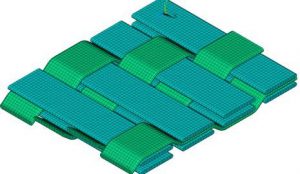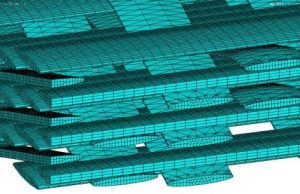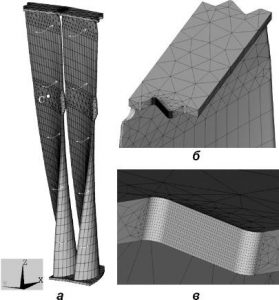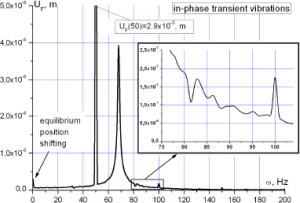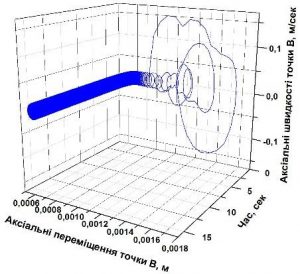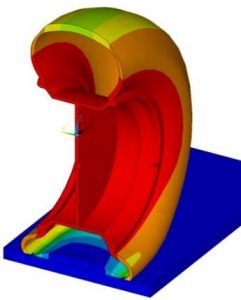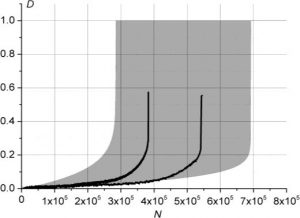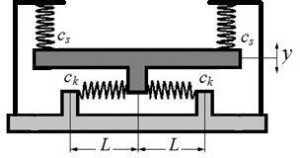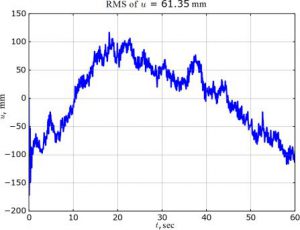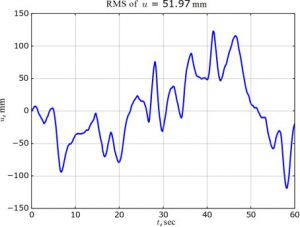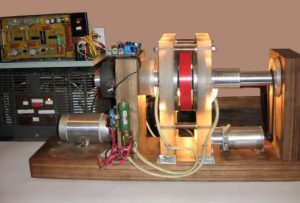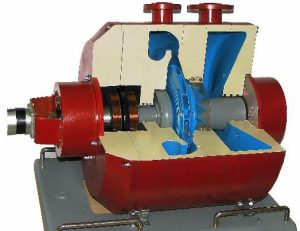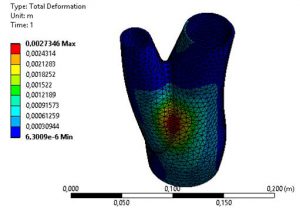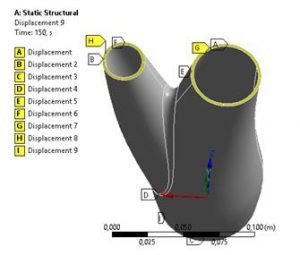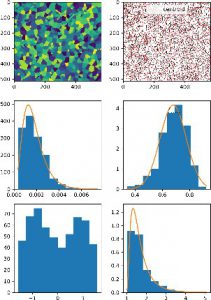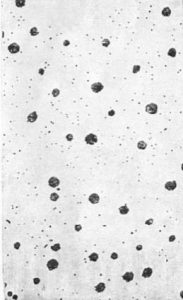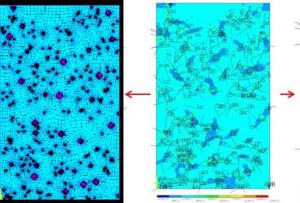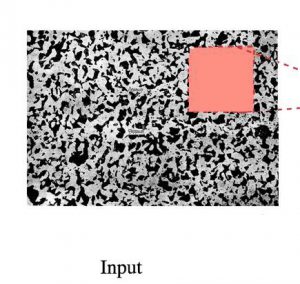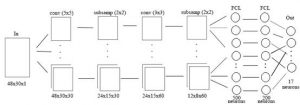Research directions of the Department of Mathematical modeling and intelligent computing in engineering (MME)
- Development of methods for designing functional anisotropic composite materials
- Forced nonlinear vibrations of turbine blades package with dynamic contact in the shroud
- Probabilistic modeling of structural failures for a prediction of mechanical engineering elements reliability
- Stochastic dynamics of the vibrational isolation systems with nonlinear suspension
- Full combined magnetic suspension of shafts and rotors in passive and active magnetic bearings
- Biomechanical computer-aided design and modeling
- Information technology for the analysis and synthesis of the structure of new materials for prediction of their physical properties
- Image microstructure estimation algorithm of heterogeneous materials for identification their chemical composition
Development of methods for designing functional anisotropic composite materials
Description
Composite materials are widely used in various fields of modern technology due to the fact that their physical and mechanical properties allow to significantly improving the technical characteristics of products. A distinctive feature of technological processes of manufacturing elements of structures from composites is the simultaneity of creating a material and a product. The change in the structure of the reinforcement makes it possible to change in the desired direction the anisotropy parameters of the stiffness, strength, and thermal-physical properties of the composite materials.
The control of anisotropy of complex modules of polymer composite materials will increase the vibrational stability of structures and create effective noise absorbing materials. The creation of new materials with a given anisotropy of the properties of heat conductivity is necessary to improve the thermal insulation coatings of buildings and structures.
Novelty and benefits
New methods is being created for designing composite materials with the required parameters for the anisotropy of physical properties based on the combined use of numerical methods for analyzing the stressed state of structural elements and numerical methods for homogenization of composites.
Outlook and perspectives
The design of composites with the required anisotropy of mechanical properties is actualy in the manufacture of industrial wind turbine blades, elements of aircraft and space engineering structures. The creation of new materials with a given anisotropy of the properties of heat conductivity is necessary to improve the thermal insulation coatings of buildings and structures.
Contact
Department Dynamics and Strength of Machines,
Supervisor of the current Scientific Direction: Prof. Gennadiy Lvov, lvovdpm@ukr.net
Forced nonlinear vibrations of turbine blades package with dynamic contact in the shroud
Description
Failures caused by the increased vibrations are widespread possible breakdowns occurring in steam and gas turbines. The blades assemblies are the most dynamically loaded units of the turbines. Inter-blades detachable joints are typically used for long blades stiffness magnification. Dynamic and strength characteristics of these designs essentially depend on the contact interacting peculiarities in such bandage. Vibrations of the blades assembly become nonlinear under dynamic contact in the bandage and can be accompanied by the great number of the various phenomena. The work deals with the investigation of the forced nonlinear vibrations of blades package of turbine, taking into account the contact interaction in the shroud.
Novelty and benefits
Analysis of the nonlinear dynamics phenomena in resonance and nonresponse regimes (a changing of resonance zones, sub and super harmonics, shifting of the system stability zone etc.).
Outlook and perspectives
– Analysis of the process of shroud contact surfaces wear and bladed disks vibrational reliability
– Analysis of the nonlinear dynamics of the turbine blades taken into account a mistuning phenomenon.
Contact
Department: Dynamics and Strength of Machines Department
Supervisor of the current Scientific Direction: Prof. Oleksiy Larin, AlexeyA.Larin@gmail.com
Probabilistic modeling of structural failures for a prediction of mechanical engineering elements reliability
Description
The work deals with a problem of the development of computational methods of determination of mechanical engineering elements life-time with random material characteristics and load. It is offered improved probabilistic models of the fatigue damage accumulation in the materials under cyclic deformation with finite strain amplitudes in the framework of continuum damage mechanics. The appropriate models take into account a random scatter of the material fatigue resistance characteristics, along with simultaneous passing of stochastic processes of material properties degradation caused by natural aging.
The approaches are developed for the determination of the probability characteristics of the machine elements fatigue damage and lifetime considering the presence of possible operational random variation of the characteristics of the deformed state.
Outlook and perspectives
– Analysis of the reliability of the elastomeric materials subject to the estimation of the influence of the self-heating process (the modelling of the self-heating of the elastomeric material under the cyclic load, analysis of cyclic heating of elastomers on their aging process).
– Development of the computational approaches for the estimation of the reliability of engineering designs considering simultaneous corrosion defects stochastic growth, material chemical degradation and the process fatigue accumulation.
Contact
Department: Dynamics and Strength of Machines Department
Supervisor of the current Scientific Direction: Prof. Oleksiy Larin, AlexeyA.Larin@gmail.com
Stochastic dynamics of the vibrational isolation systems with nonlinear suspension
Description
At the present-day engineering practice, nonlinear stiffness or damping suspension is widely used for the reduction of the vibrations. A special attention here should be made on the systems with a quasi-zero stiffness because they can provide a vibro- isolation effect together with the efficiency of usage and compact size. This work deals with the theoretical modelling and experimental observations of the vertical dynamics of a cargo platform with the quasi-zero stiffness suspension under the operational random load. A discrete non-linear computational model has been developed and analysed within numerical simulations of the random vibrations. Dynamics of the system is analysed under a kinematic stochastic wide-band stationary load. A good comparative agreement is found between the numerical simulations and experimental data.
Outlook and perspectives
– Analysis of the transient behaviour of the nonlinear vibration of such a system.
– Development of the semi-active adaptive nonlinear suspension and the algorithm of its control.
– Development of the genetic algorithms of optimal designing of the parameters of the nonlinear elastic and damping elements of a vibrational isolation suspension.
Contact
Department: Dynamics and Strength of Machines Department
Supervisor of the current Scientific Direction: Prof. Oleksiy Larin, AlexeyA.Larin@gmail.com
Full combined magnetic suspension of shafts and rotors in passive and active magnetic bearings
Description
Creating a method for constructing complete magnetic suspensions of shafts and rotors of various systems and machines. Development of new types of passive and active magnetic bearings based on a refined mathematical modeling for a calculation of force and stiffness characteristics, taking into account the laws and algorithms of the control. An introduction of passive-active magnetic suspensions for various systems and machines on a basis of carrying out various phenomena of the dynamics of rotors in magnetic bearings, considering a nonlinear interconnection of electrical, magnetic and mechanical processes.
Laboratory-experimental and experimental-exhibition models of rotors in passive- active and fully active magnetic suspensions
Novelty and benefits
– The use of passive magnetic bearings on ring permanent magnets for an organization of a more competitive full passive-active magnetic suspension.
– Practical testing of new types of passive magnetic bearings based on an application of the technique of an optimal search for parameters of a system.
– Computer simulation of rotor dynamic with passive and active magnetic.
Outlook and perspectives
Creating the new types of active and passive magnetic bearings with a development of design solutions, laws, algorithms and control systems.
A new type of passive magnetic bearings with a short-term variable stiffness to create competitive full passive-active magnetic suspensions.
Contact
Department: Dynamics and Strength of Machines Department
Supervisor of the current Scientific Direction: Dr. Martynenko Gennadii, gmartynenko@ukr.net
Biomechanical computer-aided design and modeling
Description
Theoretical (i.e. computer analysis (CAE)) of the stress state and deformation of biological bone tissues themselves and together with fixing system or implants require the development of complicated mathematical models. The main challenges here are following: complicated 3D geometry of the bone; multilayered internal structure; curvilinear orthotropy of the properties; nonlinearity of the mechanical behaviour; identification of material properties for a living tissue; specificity of the properties, geometry and loads from patient to patient; and implementation of new bio-neutral composite, functional and smart materials.
Outlook and perspectives
– the methods for parametric modelling of fixation devices and their installation based on computer tomography data that will enable adaptation to specific clinical cases;
– new rheological models of materials reflected the heterogeneity of bone structure, anisotropy of mechanical properties;
– automated software systems oriented on general usage of computer-aided design in medical practice by a staff of clinical centers orthopedics and traumatology.
Contact
Department: Dynamics and Strength of Machines Department
Supervisor of the current Scientific Direction: Dr. Martynenko Gennadii, gmartynenko@ukr.net
Information technology for the analysis and synthesis of the structure of new materials for prediction of their physical properties
Description.
Modeling the mechanical behavior of materials at the micro level allows predicting the properties of the material at the macro level. This allows to significantly reducing the cost of testing, which is necessary to determine the mechanical properties. This is especially true for high cycle fatigue and creep testing. Computer simulation and modern information technologies allow virtually generate microstructures of materials and analyze their mechanical behavior. The most popular ways to virtually generate microstructures are the methods of cellular automata and the Voronoi tessellation. On the other hand, an important direction is the analysis of already existing microstructures and their properties.
Fig. 1. Simulation of the material microstructu
Fig.2. Investigation of the stress state in cast irons with spherical inclusions at the micro level
Novelty and benefits
– Based on the computational simulation for a microstructure, it is possible to create a material with desired mechanical properties.
– Reduce the cost of experimentally determining the fatigue and creep resistance properties of new and existing materials.
– Determine the anisotropy of the properties of heterogeneous materials.
Outlook and perspectives.
Today, work is being done on the modeling of simple materials; in the future, new, complex materials are of great interest. Such materials include metals used for printing on 3D printers and etc.
Contact.
Department: Dynamics and Strength of Machines,
Supervisor of the current Scientific Direction: Dr. Oleksii Vodka, oleksii.vodka@gmail.com, https://www.researchgate.net/profile/Oleksii_Vodka2
Image microstructure estimation algorithm of heterogeneous materials for identification their chemical composition
Description.
Main objective — convolutional neural network (CNN) creation for definition of heterogeneous materials chemical composition: to create the database of images and percentage of the chemical elements corresponding to material; to develop an image recognition algorithm through programming of neural network; to estimate the received system
Outlook and perspectives.
Today, work is being done on the modeling of simple materials; in the future, new, complex materials are of great interest
Contact.
Department: Dynamics and Strength of Machines,
Supervisor of the current Scientific Direction: Dr. Oleksii Vodka, oleksii.vodka@gmail.com, https://www.researchgate.net/profile/Oleksii_Vodka2

